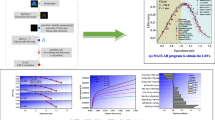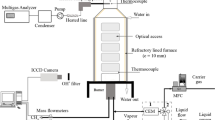Abstract
An oxygen-diluted partially premixed/oxygen-enriched supplemental combustion (ODPP/OESC) counterflow flame is studied in this paper. Flame images are obtained through experiments and numerical simulations with the GRI-Mech 3.0 chemistry. The oxygen dilution effects are revealed by comparing the flame structures and emissions with those of a premixed flame and partially premixed flame (PPF) at the same equivalence ratio (ϕΣ = 0.95 and ϕ f = 1.4). The results show that both PPF and ODPP/OESC flames have distinct double flame structures; however, the location of the premixed combustion zone and the distance between premixed/nonpremixed combustion zone are significantly different for these two cases. For the ODPP/OESC flame, the temperature in the premixed combustion zone is lower and the premixed zone itself is located farther downstream from the fuel nozzle, which leads to reduction of NO and CO emissions, as compared to those of the PPF. Therefore, by adjusting the distribution of the oxygen concentration in the premixed and nonpremixed combustion zones, the ODPP/OESC can effectively balance the chemical reaction rate in the entire combustion zone and, consequently, reduce emissions.
Similar content being viewed by others
References
R. Cònsul, A. Oliva, C. D. Pérez-Segarra, D. Carbonell, and L. P. H. Goey, “Analysis of the Flamelet Concept in the Numerical Simulation of Laminar Partially Premixed Flames,” Combust. Flame 153, 71–83 (2008).
V. Dupont and A. Williams, “NOx Mechanisms in Rich Methane–Air Flames,” Combust. Flame 114, 103–118 (1998).
M. Nishioka, S. Nakagawa, Y. Ishikawa, and T. Takeno, “NO Emission Characteristics of Methane–Air Double Flame,” Combust. Flame 98, 127–138 (1994).
L. G. Blevins and J. P. Gore, “Computed Structure of Low Strain Rate Partially Premixed CH4/Air Counterflow Flames: Implications for NO Formation,” Combust. Flame 116, 546–566 (1999).
R. V. Ravikrishna and N. M. Laurendeau, “Laser-Induced Fluorescence Measurements and Modeling of Nitric Oxide in Counterflow Partially Premixed Flames,” Combust. Flame 122, 474–482 (2000).
F. A. Williams, “Progress in Knowledge of Flamelet Structure and Extinction,” Prog. Energy Combust. Sci. 26, 657–682 (2000).
H. Mungekar and A. Atreya, “NO Formation in Counterflow Partially Premixed Flames,” Combust. Flame 148, 148–157 (2007).
T. K. Mishra, A. Datta, and A. Mukhopadhyay, “Comparison of the Structures of Methane–Air and Propane–Air Partially Premixed Flames,” Fuel 85, 1254–1263 (2006).
P. Berta, I. K. Puri, and S. K. Aggarwal, “Structure of Partially Premixed n-Heptane–Air Counterflow Flames,” Proc. Combust. Inst. 30, 447–453 (2005).
H. Machrafi, S. Cavadias, and P. Guibert, “An Experimental and Numerical Investigation on the Influence of External Gas Recirculation on the HCCI Autoignition Process in an Engine: Thermal, Diluting, and Chemical Effects,” Combust. Flame 155, 476–489 (2008).
M. Fathi, R. K. Saray, and M. D. Checkel, “The Influence of Exhaust Gas Recirculation (EGR) on Combustion and Emissions of n-Heptane/Natural Gas Fueled Homogeneous Charge Compression Ignition (HCCI) Engines,” Appl. Energy 88, 4719–4724 (2011).
J. Mi, P. F. Li, B. B. Dally, and R. A. Craig, “Importance of Initial Momentum Rate and Air-Fuel Premixing on Moderate or Intense Low Oxygen Dilution (MILD) Combustion in a Recuperative Furnace,” Energy Fuels 23, 5349–5356 (2009).
A. A. Konnov, I. V. Dyakov, and J. Ruyck, “The Effects of Composition on the Burning Velocity and NO Formation in Premixed Flames of C2H4 + O2 + N2,” Exp. Therm. Fluid Sci. 32, 1412–1420 (2008).
R. N. Roy and S. Sreedhara, “A Numerical Study on the Influence of Airstream Dilution and Jet Velocity on NO Emission Characteristics of CH4 and DME Bluff-Body Flames,” Fuel 142, 73–80 (2015).
Z. S. Wang, H. B. Zuo, Z. C. Liu, W. F. Li, and H. L. Dou, “Impact of N2 Dilution on Combustion and Emissions in a Spark Ignition CNG Engine,” Energy Convers. Manag. 85, 354–360 (2014).
J. Sidey, E. Mastorakos, and R. L. Gordon, “Simulations of Autoignition and Laminar Premixed Flames in Methane/Air Mixtures Diluted with Hot Products,” Combust. Sci. Technol. 186, 453–465 (2014).
H. Gotoda, S. Kawaguchi, and Y. Saso, “Experiments on Dynamical Motion of Buoyancy-Induced Flame Instability under Different Oxygen Concentration in Ambient Gas,” Exp. Therm. Fluid Sci. 32, 1759–1765 (2008).
S. Candel, “Combustion Dynamics and Control: Progress and Challenges,” Proc. Combust. Inst. 29, 1–28 (2002).
C. Stone and S. Menon, “Swirl Control of Combustion Instabilities in a Gas Turbine Combustor,” Proc. Combust. Inst. 29, 155–160 (2002).
Y. Y. Wu and K. D. Huang, Improving the Performance of a Small Spark-Ignition Engine by Using Oxygen-Enriched (SAE-2007-32-0004).
Z. X. Cheng, J. A. Wehrmeyer, and R. W. Pitz, “Experimental and Numerical Studies of Opposed Jet Oxygen-Enhanced Methane Diffusion Flames,” Combust. Sci. Technol. 178, 2145–2163 (2006).
G. P. Smith, D. M. Golden, M. Frenklach, et al., GRI-Mech 3.0 (1999). http://www.me.berkeley.edu/gri mech/version30/text30.html.
J. S. Park, J. H. Dong, J. Park, J. S. Kim, and S. Kim, “Edge Flame Instability in Low-Strain-Rate Counterflow Diffusion Flames,” Combust. Flame 146, 612–619 (2006).
H. K. Chellian, C. K. Law, T. Ueda, M. D. Smooke, and F. A. Williams, “An Experimental and Theoretical Investigation of the Dilution, Pressure and Flow-Field Effects on the Extinction Condition of Methane–Air–Nigtrogen Diffusion Flames,” Proc. Combust. Inst. 23, 503–511 (1991).
L. G. Blevins and W. M. Pitts, “Modeling of Bare and Aspirated Thermocouples in Compartment Fires,” Fire Saf. J. 33, 39–59 (1999).
A. E. Lutz, R. J. Kee, J. F. Grcar, and F. M. Rupley, “OPPDIF: A Fortran Program for Computing Opposed-Flow Diffusion Flames,” Report No. SAND-96-8243 (Sandia National Laboratory, 1997).
H. S. Xue, S. K. Aggarwal, R. J. Osborne, T. M. Brown, and R. W. Pitz, “Assessment of Reaction Mechanisms for Counterflow Methane–Air Partially Premixed Flames,” AIAA J. 40, 1236–1238 (2002).
R. S. Barlow, A. N. Karpetis, J. H. Frank, and J. Y. Chen, “Scalar Profiles and NO Formation in Laminar Opposed-Flow Partially Premixed Methane/Air Flames,” Combust. Flame 127, 2102–2118 (2001).
C. J. Sung, C. K. Law, and J. Y. Chen, “Augmented Reduced Mechanisms for NO Emission in Methane Oxidation,” Combust. Flame 125, 906–919 (2011).
M. Mikami, Y. Mizuta, Y. Tsuchida, and N. Kojima, “Flame Structure and Stabilization of Lean-Premixed Sprays in a Counterflow with Low-Volatility Fuel,” Proc. Combust. Inst. 32, 2223–2230 (2009).
H. Watanabe et al., “Characteristics of Flamelets in Spray Flames in a Laminar Counterflow,” Combust. Flame 148, 234–248 (2007).
C. H. Wang, G. J. Ueng, and M. S. Tsay, “An Experimental Determination of the Laminar Burning Velocities and Extinction Stretch Rates of Benzene/Air Flames,” Combust. Flame 113, 242–248 (1998).
H. S. Xue and S. K. Aggarwal, “NOx Emissions in n-Heptane/Air Partially Premixed Flames,” Combust. Flame 132, 723–741 (2003).
Author information
Authors and Affiliations
Corresponding author
Additional information
Original Russian Text © J. Luo, L. Tian, L.-Sh. Liu, Z.-Zh. Cheng.
Published in Fizika Goreniya i Vzryva, Vol. 53, No. 5, pp. 13–23, September–October, 2017.
Rights and permissions
About this article
Cite this article
Luo, J., Tian, L., Liu, LS. et al. Study on flame structures and emissions of CO and NO in Various CH4/O2/N2–O2/N2 counterflow premixed flames. Combust Explos Shock Waves 53, 500–509 (2017). https://doi.org/10.1134/S0010508217050021
Received:
Revised:
Published:
Issue Date:
DOI: https://doi.org/10.1134/S0010508217050021




